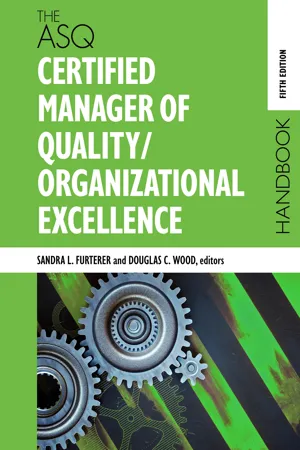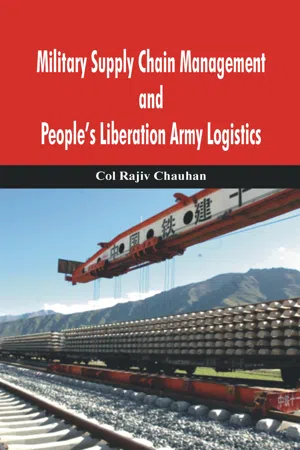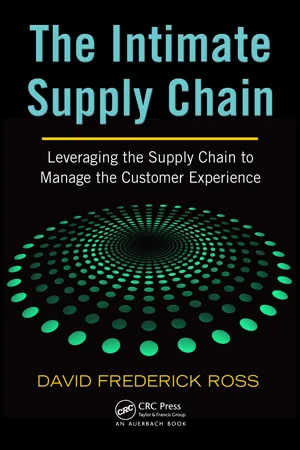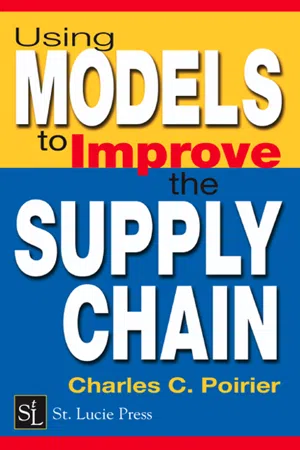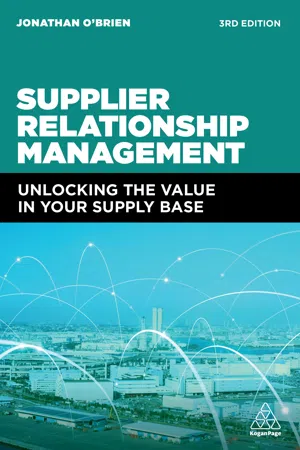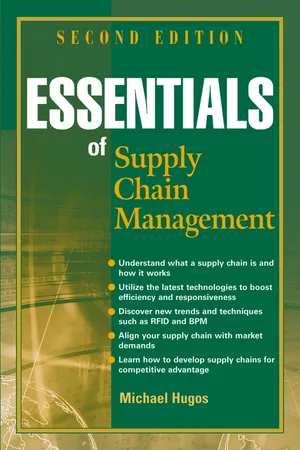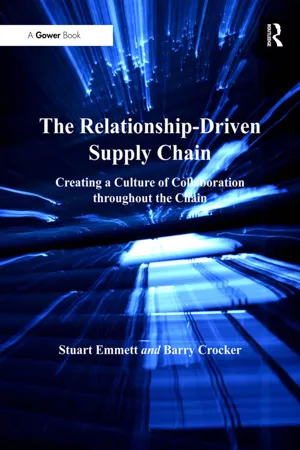Business
Improving the Supply Chain
Improving the supply chain involves optimizing the flow of goods and services from the point of origin to the point of consumption. This can be achieved through streamlining processes, enhancing communication and collaboration with suppliers, and leveraging technology to increase efficiency and visibility. By improving the supply chain, businesses can reduce costs, minimize waste, and enhance customer satisfaction.
Written by Perlego with AI-assistance
Related key terms
Related key terms
1 of 4
Related key terms
1 of 3
11 Key excerpts on "Improving the Supply Chain"
- Douglas C. Wood, Sandra L. Furterer(Authors)
- 2021(Publication Date)
- ASQ Quality Press(Publisher)
Part VI Supply Chain Management
World-class supply chains organize, plan, and deliver on the basis of what customers value. —Gene Tyndall, Christopher Gopal, Wolfgang Partsch, and John KamauffChapter 18 Supply Chain Management Contributor: Heather McCain Passage contains an image Chapter 18 Supply Chain Management
A systems view of an organization recognizes that performance is a function of taking in inputs (marketplace and customer requirements, operating funds, raw materials and supplies, and employees) and effectively and efficiently converting them to outputs deemed of value by customers. It is, therefore, in the best interest of organizations that they select and work with suppliers in ways that will ensure high quality of those inputs to reduce the risk of unwanted waste. Strategic sourcing is a process for reducing the total cost of purchased materials, goods, and services while maintaining and/or improving levels of operating efficiency, quality, technical innovation, customer service, and safety.1 Strategic sourcing requires the purchasing organization to work with suppliers to develop strategies that are mutually beneficial.According to ASQ’s Quality Glossary , a supplier is a source of materials, service, or information input provided to a process. External suppliers may be used at any stage in the design, production, and/or delivery process. Supply chain management (SCM) is a system in which supplier quality is managed by using a proactive and collaborative approach. This management approach begins early in the product design and supplier selection process. It continues through the entire life cycle of a product and for the duration of the relationship with that particular supplier.2 SCM, defined as the process of effectively integrating and managing the supply chain, is a series of processes including planning, sourcing, making, delivering, and returning. This chapter focuses on the planning, sourcing, and delivering aspects of SCM.3- Rajiv Chauhan(Author)
- 2015(Publication Date)
- VIJ Books (India) Pty Ltd(Publisher)
The underlying philosophy of supply chain management is that of the planning and coordinating the materials flow from the source to user as an integrated system rather than, as was often the case in the past managing the goods flow as a series of independent activities. The goal is to link the distribution network, the manufacturing process and the procurement activity in such a way that customers are serviced at higher levels and yet at lower cost to achieve the goal of competitive advantage through both cost reduction and service enhancement. It requires both internal functional and external functional integration.The mission is to plan and coordinate all those activities necessary to achieve the desired levels of delivered service and the quality at lowest possible cost. It is the link between the Market Place and the operating activity of the business. The scope spans the organisation from the management of raw materials through the delivery of the final product. In the past firms sought to achieve cost reduction or profit improvements at the expense of the supply chain partners. Now they have realised the fallacy and are striving to make the entire supply chain competitive, through added value and reduced costs.One of the key attributes of a manager is to successfully respond to the end consumer demand. To maximize competitive advantage all members of the organization should work seamlessly to serve the consumer. Integrated logistics is considered to include all aspects of planning, allocating, and controlling the financial and human resources committed to manufacturing support and purchasing operations as well as physical distribution. Management must lead the processes to be efficient, flexible, reliable and resilient. Best use of limited assets and resources to serve customers in a competitive mode should be the overriding aim. Various definitions of what a supply chain constitutes and the basic tenets of its management are listed out in the succeeding paragraphs.DefinitionsThe field of study known as supply-chain management involves many academic converging disciplines. This has been synergised by the introduction of Material Resource Planning (MRP), Enterprise Resource Planning (ERP) and Distribution Resource Planning (DRP). A multitude of definitions have been proposed concerning the concept of “the supply chain”.- eBook - ePub
Strategic Supply Chain Alignment
Best Practice in Supply Chain Management
- John Gattorna, John Gattorna(Authors)
- 2017(Publication Date)
- Routledge(Publisher)
Chapter 2 Strategic supply chain management Creating shareholder value by aligning supply chain strategy with business strategyRobert Evans and Alister DanksManagement of the supply chain has evolved over the last two decades from an emphasis on integrating logistics and lowering costs to providing better products and services to customers, quickly and cheaply. Now, with the advent of the twenty-first century, the challenge is to take supply chain management to a more strategic level within the firm. This chapter describes how to formulate and establish a supply chain strategy and, most importantly, how to align the strategy with the organization’s overall business strategy. By elevating supply chain management to the heart of decision making in the boardroom, and uniting corporate and supply chain goals, companies can boost profitability and growth and substantially increase their shareholder value.Introduction
The role of supply chain management within an organization has changed considerably over the last three decades.In the 1970s supply chain management, then known primarily as ‘distribution’, was focused on the integration of warehousing and transportation within the firm. In addition, the high, double-digit interest rates that existed in most countries during the decade encouraged firms to pay particular attention to their use of capital. Supply chain managers focused heavily on reducing inventories. At this point, the focus was principally on how the firm could make internal changes that would reduce inventories and distribution costs. Even efforts to reduce plant and supplier lead times, and consequently safety stocks, can be considered as being internally focused, since lead times were considered primarily as ‘inputs’ to the forecasting and procurement processes.In the 1980s the focus of supply chain management shifted to the reengineering of supply chain cost structures. Attention was directed to integrating the firm’s supply chain processes in a manner that would lower supply chain operating costs and reduce supply chain assets. These efforts were not without considerable rewards. According to Herbert W. Davis & Co., North American supply chain costs, including finished goods transportation, warehousing, order entry, customer service, administration and inventory carrying costs, declined by nearly one-third between 1982 and 1990, as shown in Figure 2.1 - eBook - ePub
The Intimate Supply Chain
Leveraging the Supply Chain to Manage the Customer Experience
- David Frederick Ross(Author)
- 2008(Publication Date)
- Auerbach Publications(Publisher)
What is needed are practical approaches to utilizing the basic tenets of SCM to fashion new strategies and best practices that will provide fresh insights into today’s supply chain issues and enable a seaway into realizing tomorrow’s opportunities. Such an understanding illuminates the very nature of SCM, which is always evolving to respond to the changes incessantly occurring in the marketplace. Today, SCM has the following six challenges before it:- Creating new avenues for supply chains to be more intimate with the customer by understanding what constitutes individual customer value and providing an unsurpassed buying experience.
- Ensuring the long-term profitability of the supply chain and each network partner by removing barriers to higher levels of supply chain efficiency and effectiveness.
- Increasing the level of collaboration and access to channel partner competencies by sharing data, intelligence, and more closely aligning organizations.
- Architecting supply chains consisting of productive assets that are agile and flexible enough to respond to any marketplace challenge.
- Increasing the velocity of inventory and delivery network processes while continually reducing costs.
- Enabling greater levels of connectivity to more closely interweave the knowledge and skills of cross-channel teams.
While there are many variants, supply chain strategists have narrowed the response to these challenges to three distinct approaches. The first has coalesced around cost leadership and encompasses a set of principles and tools designed to increase supply chain productivity and profitability by ruthlessly reducing wastes found anywhere in the channel network. This method is known as lean supply chain management. The second approach, operations performance, is focused on ensuring supply chain execution functions are as agile as possible in the face of demand variability. This method can be concerned with supply flexibility and is known as adaptive supply chain management or it can be concerned with delivery flexibility and is known as demand-driven supply network management. The final approach, customer centered, is concerned with the continuous development of supply chain capabilities and resources to provide total value to the customer. This method is known as intimate supply chain management. The remainder of this chapter will focus on lean SCM. Chapter 6 will then proceed to a discussion of the concepts and principles of adaptive supply chains and demand-driven supply networks. Finally, chapters 7 and 8 - eBook - ePub
- Charles C. Poirier(Author)
- 2003(Publication Date)
- CRC Press(Publisher)
Supply chain is the latest business performance improvement effort for good reason as the results are proving. It is the umbrella process under which a firm can merge the best of its previous continuous improvement efforts to gain the next level of better performance and customer satisfaction. Taking best advantage of supply chain management requires defining the end-to-end process steps involved, the scope of what must be achieved, and then progressing through evolutionary levels to the level necessary for the firm to achieve a market advantage. Moving through each of the intermediate levels is important to bring the organization to optimum conditions, as the house must be in order before working on alliances with external partners. As firms move to the external environment required for the higher level of progression, they find getting to the most advanced levels requires collaboration with a select group of supply chain partners working as a network focused on specific customer or consumer groups.As this collaboration proceeds, the network of partners will get to the highest level by working through models that guide progress and show where appropriate technology and Internet-based applications will enhance the effort. We will expand on this thinking as we now begin to consider the many supply chain models that can result in a firm and its partners dominating a chosen market or industry. - eBook - ePub
Supplier Relationship Management
Unlocking the Value in Your Supply Base
- Jonathan O'Brien(Author)
- 2022(Publication Date)
- Kogan Page(Publisher)
network and across the literature out there it can be difficult to understand exactly which bit each is focusing on, leaving the reader to fill in the gaps. Hieber (2002) states that:Whilst many proponents of SCM talk at length about the supply side, others suggest the chain or network continues right to the end customer. Melzer-Ridinger (2003) suggests:Supply Chain Management is the integration of the activities associated with the flow and transformation of goods in the respective logistics networks through improved supply chain relationships based on a common collaborative performance measurement framework for attaining close, collaborative and well coordinated network relationships to achieve a sustainable competitive advantage.SCM has the task to design and operate the flow of material into, through and out of the enterprise as well as the relevant administrative information and coordination processes in a way to guarantee an error-free, robust, quick and efficient servicing of the final client.This is also supported by Mentzer et al (2001) who suggest the philosophy of SCM must include the ability to view the entire supply chain and manage the flow of goods from supplier to ultimate customer.There are many views on exactly what SCM does and concerns itself with; to some it is little more than the flow of materials to suit the purposes of the firm whilst to others it is about relations and interactions throughout the system, the flow of information and targeted interventions to increase end customer value. It is easy to get lost in the broad range of definitions out there, all waving the SCM banner so in this chapter I will attempt to summarize the key concepts. In terms of definitions, the one that I favour that seems to be the simplest is that of Christopher (2011), a definition that is quite a few years old now but remains very relevant, who describes SCM as: - eBook - ePub
- Ian Sadler(Author)
- 2007(Publication Date)
- SAGE Publications Ltd(Publisher)
8
Implementing Change in the Supply Chain
In strategic thinking one first seeks a clear understanding of the particular character of each element of a situation and then makes the fullest possible use of human brain power to restructure the elements in the most advantageous way.1Objectives
- To check whether a supply chain is performing for customers and its companies
- To find out which supply chain activities add value quickly and which processes need to be simplified to perform better
- To carry out strategic change throughout all the partners in a supply chain to achieve major long-term improvements
INTRODUCTION
Previous chapters have examined logistics in various types of companies, described several important topics such as 'Information Communication' and provided a method to integrate logistic activities through supply chains. This chapter investigates means of engendering revolutionary change in chains. It starts by investigating how well the supply chain is performing. Secondly it examines an important technique to generate quick improvements, lean value stream mapping. Thirdly it describes one method of achieving major change in supply chains by joint strategic planning involving several key partners. Finally, the chapter takes stock of present knowledge and suggests the goal of supply chain strategy.8.1 MEASURE CURRENT PERFORMANCEBefore change can be implemented in a supply chain, we need to know how well it is performing. Existing company measures are unlikely to cover the whole supply chain. They are probably focused on the one company. So a new set of metrics for the wider task will probably be required. - eBook - ePub
- Ron Basu, J. Nevan Wright(Authors)
- 2006(Publication Date)
- Routledge(Publisher)
In addition, each organization – manufacturing or service – is in some way unique, and although there is a tendency to exaggerate this, it is still a fact that what will work for one business will not necessarily work as effectively for another. There can be a variety of reasons why one technique, seemingly successful for one organization, will not work quite as well for another. Reasons can include the type of business, the management style of the chief executive and the overall culture of the organization. Often a change to TQM or to BPR will require a major change in management styles and in the culture of the organization.There is however one approach that is becoming increasingly recognized as a certain way of meeting customer specifications and reducing effort and wastage of resources but which does not require a major change in direction and culture. This approach constitutes our second pillar: Supply Chain Management.What is a Supply Chain?If you asked people involved in business to define the term supply chain you would get many different answers. Each definition would reflect the nature of the business and the inputs and outputs that it produced. For some, supply chain is related to purchasing and procurement, to others it is warehousing, distribution and transportation. Yet for others it would be sources of capital and labour.In a typical supply chain, raw materials are procured and items are produced at one or more factories, shipped to warehouses for intermediate storage and then shipped to retailers or customers. Melnyk and Swink (2002) give the following holistic definition of the supply chain as:The entire network of organizations involved in:- converting raw materials and information into products and services
- consuming the products and services, and
- disposing of the products and services.
They further state that ‘this definition treats the supply chain as a product cradle-to-grave concept, including all value added activities required to plan, source, make and deliver products and services that meet customer needs’.The Supply Chain in ManufacturingSupply chain management in a manufacturing and supply organization considers demand, supply and inventory needs for each item of production and in particular looks at how inventory flows through the system to achieve output to the customer’s specification on time and at least cost. With supply chain management, customer service is increased through the reduction of lead times and the product is always exactly as specified and it is always delivered on time. Costs are reduced through the elimination of any activity that doesn’t add value and through the elimination of any non-essential increment of material. - eBook - ePub
Supply Chain Strategies
Demand Driven and Customer Focused
- Tony Hines(Author)
- 2024(Publication Date)
- Routledge(Publisher)
4 The emergence of supply chain management and supply chain strategy as a critical success factor for organizationsDOI: 10.4324/9781003393290-4Introduction
The purpose of this chapter is to discuss the emergence of supply chain management, the underlying concepts and the development of supply chain strategies as an important influence upon successful organization strategies and operations. The chapter begins with a discussion of historical developments generally and in organizational management that have created the necessary conditions for the emergence of supply chains as an important focus for managers. It then moves on to address contemporary issues that occupy the mind space of practising managers. Empirical examples demonstrate the importance of the supply chain phenomena in creating successful strategies, structures and relationships that enhance organizational value. Finally, future directions are considered before outlining a new research agenda for this developing and important aspect of business management.Supply chain management was a phrase first coined in the early 1980s to describe the range of activities co-ordinated by an organization to procure and manage supplies (Oliver & Webber, 1982 ). Initially the term referred to an internal focus bounded by a single organization and how they sourced and procured supplies, managed their internal inventory and moved goods on to their customers, (Harland, 1995 ; Macbeth & Ferguson, 1990 ). The original focus was later extended to examine not simply the internal management of the chain. It was recognized that this was inadequate and that the reality in managing supplies meant that supply chains extended beyond the purchasing organization and into their suppliers and their supplier’s supplier (Christopher, 1992 - eBook - ePub
- Michael H. Hugos(Author)
- 2010(Publication Date)
- Wiley(Publisher)
CHAPTER 7Defining Supply Chain OpportunitiesAfter reading this chapter you will be able to• Apply the market analysis framework to define the type of markets your company serves and identify the performance capabilities most valuable to those markets • Define performance targets for your company to succeed in the markets you serve—the goal • Create a strategy and define the objectives needed to reach the goal • Estimate the budget needed for this effort and calculate the return on investment (ROI) • Create the high-level project plan that will guide the effortNow that conscious design and real-time management of a company’s supply chain is possible, how does a company use this ability to its competitive advantage? A well designed and managed supply chain will enable a company to offer high levels of customer service and at the same time hold its inventories and cost of sales to levels lower than its competitors. This chapter will lay out a process to use for defining the supply chain management opportunities available to a company.The Supply Chain as a Competitive Advantage
As companies such as Wal-Mart and Dell Computer have so clearly shown, if a company can design and build a supply chain that is responsive to market demands, it can grow from a small company to become a major player. Efficient supply chain operations are central to being able to satisfy market demands and to do so in a way that is profitable. Where once markets were shaped by the availability of product, now they are shaped by the evolving demands (some might say whims) of the end use customers. Availability of most products is now taken for granted. So in addition to the product itself, the market has a host of other requirements in the areas of customer service, demand flexibility, and product development. A company needs to understand where it fits in the supply chains of the markets it serves. Then it needs to decide which activities it will focus on to deliver value. - eBook - ePub
The Relationship-Driven Supply Chain
Creating a Culture of Collaboration throughout the Chain
- Stuart Emmett, Barry Crocker(Authors)
- 2016(Publication Date)
- Routledge(Publisher)
Additional benefits of SCM will only come when there is an examination of all costs/service levels together with all the players. This should produce reduced lead times and improved total costs/service for all parties in the network. This will mean, therefore, going beyond the first tier of suppliers and looking also at the supplier’s supplier and so on. It represents more than sharing data and processes: it includes mutual interest, open relationships and sharing. The optimum and the ideal cost/service balance will only ever be found by working and collaborating fully with all players in the supply chain.A key area here is to balance the service aspects with the costs. Whilst individual companies will need to assess costs for themselves, it can be expected that between 30 and 70 per cent of business cost will be in the supply chain; indeed, cost is a common language to anyone in the supply chain. Managing efficiently and effectively the flows of goods and information across the supply chain networks is therefore essential in bringing about the cost/service balance; a big promise and never an easy approach but resulting in the perfect ideals of:• increased/improved service, reaction times, product availability and so on; • reduced/improved total cost, total stock levels, time to market and so on.Five key aspects for supply chain management
One starting point to developing a better understanding is by mapping a supply chain. This will identify the many parts/players/participants that are involved beyond the first-level contacts. Process mapping covers different techniques ranging from simple flow charts to value stream maps and beyond. Process mapping can be a complex process and one that may usefully be led by external consultants and advisors. Even simple approaches however, are usually very revealing, for example:1. Determine the company units involved. 2. Agree steps with the people doing the work. 3. Identify the start and end of each process. 4. Go to the next upstream and downstream processes and repeat 1–3. 5. Lay out all the step processes in a flow chart. 6. Insert the lead times between and within each process.
Index pages curate the most relevant extracts from our library of academic textbooks. They’ve been created using an in-house natural language model (NLM), each adding context and meaning to key research topics.
Explore more topic indexes
Explore more topic indexes
1 of 6
Explore more topic indexes
1 of 4
